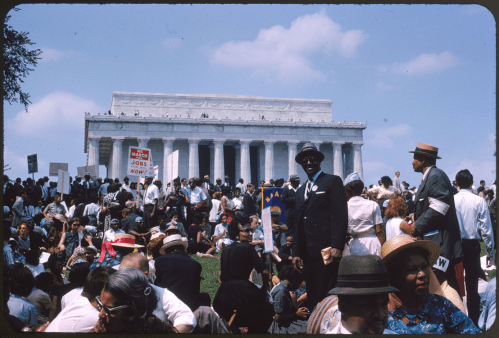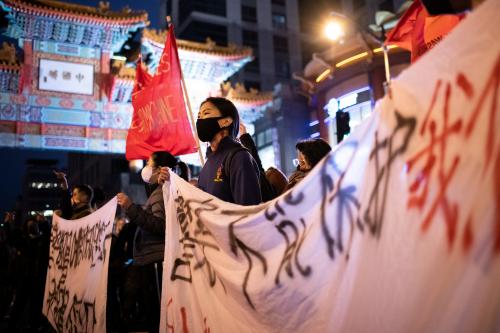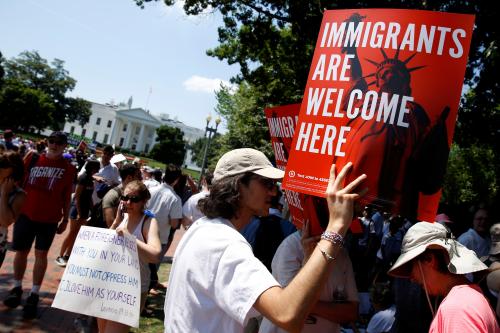The Boston Marathon bombings highlighted, once again, the challenges of assimilating Muslim youth. And while the onus of accountability ought not rest exclusively on Muslim Americans, it understandably weighs most heavily on them. Indeed, any fair-minded assessment of recent events must underscore the inadequacies of Muslim-American leaders. Yet the usual criticisms are wide of the mark and fail to identify the institutional as well as intellectual weaknesses of these leaders.
In general we too easily overlook—even in the midst of a raging debate over our immigration policy—what Norman Podhoretz once referred to as “the brutal bargain” that immigrant children must accept in order to assimilate into the society their parents chose for them. For Muslims today, the drama involves not so much overcoming poverty and educational deficits but adapting to a society whose values are sharply at odds with their religious heritage. Among Muslim-American youth, especially since 9/11, this has led to heightened criticism and suspicion of U.S. government policies at home and abroad. More generally, it has resulted in a hard-edged identity politics that has encouraged some young Muslims to define themselves not only in opposition to the government but to American society and culture.
Marcia Hermansen, a Muslim who is also a professor of Islamic studies at Loyola University in Chicago, recounts her shock when she “encountered some Muslim students on my campus who seemed to feel vindicated by the destruction and loss of life on September 11.” As she elaborates, “Quite a number of Muslim youth in America are becoming rigidly conservative and condemnatory of their peers (Muslim and non-Muslim), their parents, and all who are not within a narrow ideological band of what I will define as internationalist, ‘identity’ Islam.”
This trend was picked up by Pew pollsters who reported in 2007 that Muslims older than 30 were much less likely (28 percent) than those aged 18-29 (42 percent) to agree that “there is a natural conflict between being a devout Muslim and living in a modern society.” When it surveyed Muslims again in 2011, Pew asked if “there is only one true way to interpret the teachings of Islam”: 31 percent of foreign-born Muslims agreed, but 46 percent of native-born Muslims did. Also that year, Pew found that 58 percent of foreign-born Muslims agreed “the American people are generally friendly toward Muslim Americans,” compared with only 37 percent of their native-born offspring.
Among many Muslim-American youth, there is self-conscious rejection of their parents’ easygoing, traditionalist understanding of Islam, inevitably suffused with the customs of their homeland. The youthful response is frequent invocations of the ummah, the worldwide community of Muslims that ideally transcends all barriers of ethnicity, race, and nationality. Sustained by such Islamist constructs, young Muslims on college campuses often trump their parents’ insistence that they marry within their ethnic group with a religiously grounded ethic that prioritizes marrying another Muslim regardless of ethnic or racial background.
As Hermansen notes, such youthful perspectives entail a “religious and cultural superiority … a mindless and rigid rejection of ‘the Other’ … a smug pride in one’s superior manifestation of visible symbols of identity.” One result is a preoccupation with “the evils of Western cultural elements such as the celebration of birthdays, Halloween, and prom night.” And while this mindset does not typically lead to violence, it was clearly on display when Tamerlan Tsarnaev disrupted speakers at his Cambridge mosque when they embraced the celebration of American national holidays such as Thanksgiving and praised a non-Muslim religious leader, Martin Luther King Jr.
Hermansen argues that such views have been “allowed to run unchecked and uncriticized . . . even been encouraged among youth by mainstream Muslim organizations in America.” In fact, Muslim-American leaders have themselves espoused such views, especially before 9/11. Yet since then, these leaders have been struggling, however opportunistically, to adapt to the realities of American life. The problem is that they have all too often led their followers down blind alleys.
For example, in the 1970s and 1980s Muslim leaders explicitly urged their people to avoid assimilating into the American mainstream and to withdraw into Islamic community centers, schools, and colleges. Paradoxically, they also encouraged Muslims to do dawa and seek to convert the very Americans they were to shun. Similarly, these leaders denounced U.S. foreign policies impacting the ummah but discouraged Muslims here from participating in the political process.
Since 9/11, Muslim leaders have shown a remarkable—and largely unnoted, or disbelieved—willingness to adapt to America. Indeed, these leaders have been busily reconstructing an anodyne version of Islam that conforms to the American civil religion. Yet once again, they are leading the faithful into various double-binds.
So today Muslim Americans are being reassured that it is permissible—even desirable—to have non-Muslim friends. And that it is okay to attend business lunches where non-Muslim colleagues drink alcohol. And that it is definitely a good idea to vote and get involved in civic and political affairs.
Other topics are addressed with discretion. Explicit displays of Islamic triumphalism are now rare. The topic of intermarriage with non-Muslims is typically avoided. Controversial political issues get finessed. Since 9/11, Muslim Americans have learned to be much more discreet about their views on Palestine and U.S. support for Israel. Much of the energy concerning such issues has been rechanneled into opposition to the wars in Afghanistan and especially in Iraq or to the Obama administration’s reliance on drones.
Similarly, Muslim Americans feel free to indulge their vehement opposition to profiling at airports and to the Patriot Act. As for domestic policy, Muslims can be heard voicing support for efforts addressing racial and gender discrimination and for comprehensive immigration reform. More generally, they support social welfare programs, including Obamacare.
If all of this sounds familiar, it should. This is the Democratic agenda, which over the past decade Muslim-American leaders have visibly embraced. But this has meant their virtual silence on an array of social and cultural issues on which Muslim opinion continues to diverge from that of their newfound allies. Unlike before 9/11, when Muslims were lining up with Republicans, their leaders are no longer outspoken about alcohol abuse, drugs, gambling, pornography, and abortion.
Gay rights is the one cultural issue on which Muslim-American leaders have taken a U-turn, and it sustains my point that they are not well positioned to speak forthrightly and authoritatively to their own people, especially to questioning youth. Twenty years ago, these leaders condemned homosexual rights as an aspect of American society that justified withdrawal from the mainstream. Today, Muslim leaders are hardly barnstorming for gay rights, but they have ceased condemning homosexuals and homosexuality and have embraced tolerance.
A prime example of this shift is William Suhaib Webb, imam of the controversial Islamic Society of Boston Cultural Center. A few years ago Webb emphasized Islam’s condemnation of homosexuality to an audience of young Muslims. With regard to gay marriage, he asked: “Why are we so quiet? We have something to offer society, and we should ask America nicely what has happened to your values in 40 years?” Yet in a Boston Globe interview last month, Webb said that with regard to gay marriage he had made “mistakes” and was reluctant “to start arguing about other people’s liberties,” claiming that the Constitution guarantees the right of everyone to get married.
Such bold revisionism has to alienate as many Muslims—including young people—as it gratifies. But such U-turns are undoubtedly easier for a handful of leaders, like Suhaib Webb, whose skillful use of the national media has permitted them to reach beyond the confines of a given mosque or local Muslim community. Indeed, in most such contexts it is seldom clear who the leaders really are. To be sure, this dilemma is endemic to Sunni Islam and can be traced to its decentralized, non-hierarchical structure. Yet in America, with Muslims from around the globe struggling to coexist in self-governing mosques, leadership is all the more problematic.
In most mosques here, leadership is up for grabs. Contrary to what non-Muslims think, imams are not necessarily in charge. They are typically foreigners who understand Islam but lack specific knowledge about American culture, society, and politics. Their command of English may also be limited.
The imam gets hired by the mosque governing board. In most countries mosques are subsidized by the state, but here they are self-supporting voluntary institutions. So the board’s other major responsibility is the institution’s financial viability, and it tends to be dominated by key donors, invariably affluent professionals—stereotypically, Pakistani doctors and engineers. The most assertive or most generous member is likely to be board president, who may easily overshadow the imam and become the de facto leader of the mosque.
This dynamic can be a source of tension and conflict, which are invariably exacerbated by the diversity of the congregation. Because Shia and Sunni tend to worship separately, this sectarian divide does not typically trouble mosques here. But social class antagonisms do arise—for example, between successful doctors and struggling cab drivers. And disagreements emerge between more established Muslims who have invested time and resources in the mosque and recently arrived immigrants who take it all for granted and, in addition, have divergent understandings of Islam.
The sharpest divides may arise from linguistic, ethnic, and racial differences. These could involve disagreements over the different madhabs, or schools of Islamic jurisprudence. And so, Arabs and South Asians tend to establish their own mosques. Nevertheless, most mosques have mixed congregations with a variety of languages and cultures from around the globe. Then there are racial divides, especially with regard to African-American Muslims. And quite apart from religion, Muslim immigrants bring with them from their home countries different political orientations and agendas.
In such contexts, leadership is not easy to exercise. Whoever is “in charge” is likely to be cautious and risk-averse. Of course, what looks cautious from inside may look outrageous from outside. Thus, one imam relates that it would be “career suicide” to denounce the violent Islamist Sayyid Qutb to his members—even as this same imam preaches tolerance to his congregation and beyond. Conversely, it is easy and useful for imams and other Muslim leaders to attack the war on terror, the Patriot Act, and other such policies on which there is nearly unanimous opposition.
This article was originally published in the Weekly Standard »



Commentary
Problems of the Second Generation: To be Young, Muslim, and American
June 28, 2013